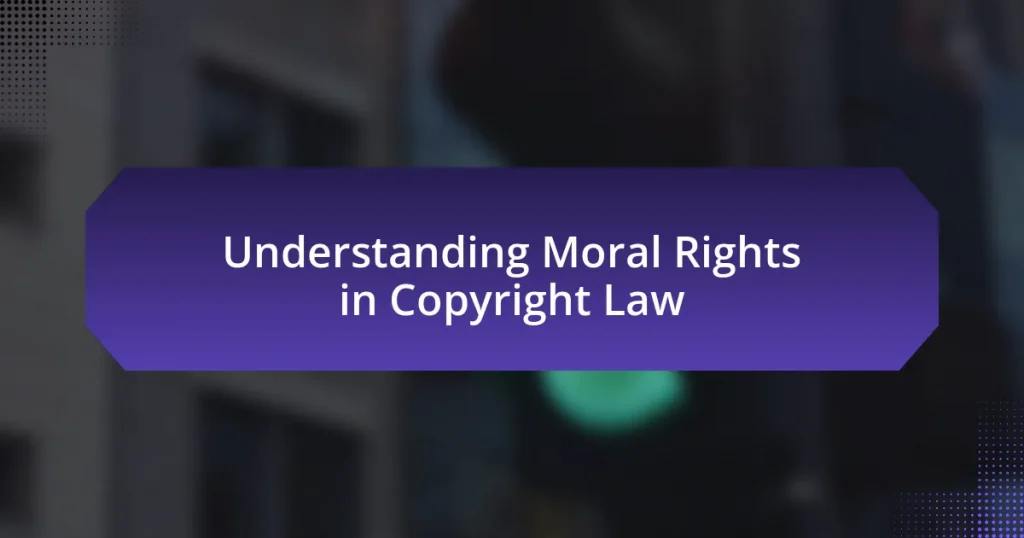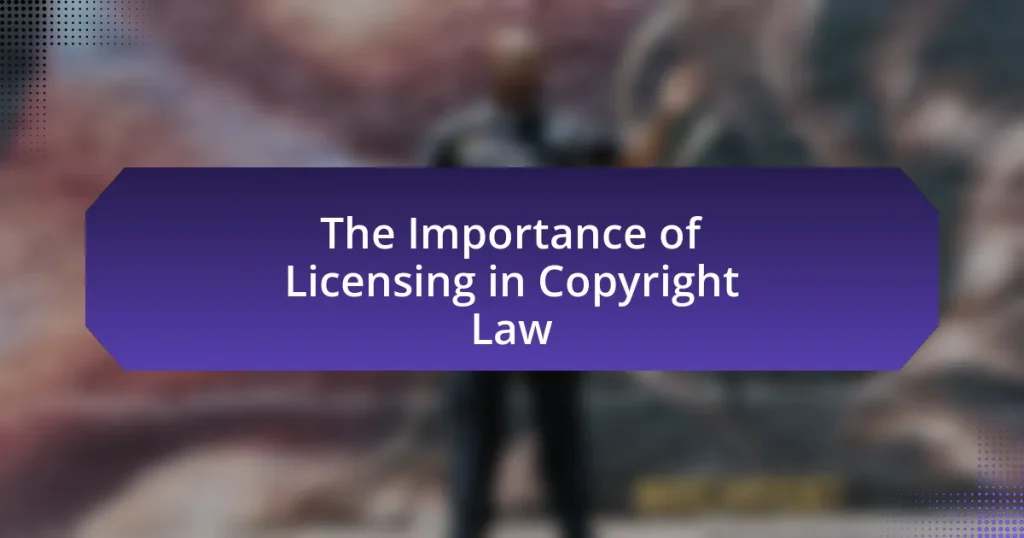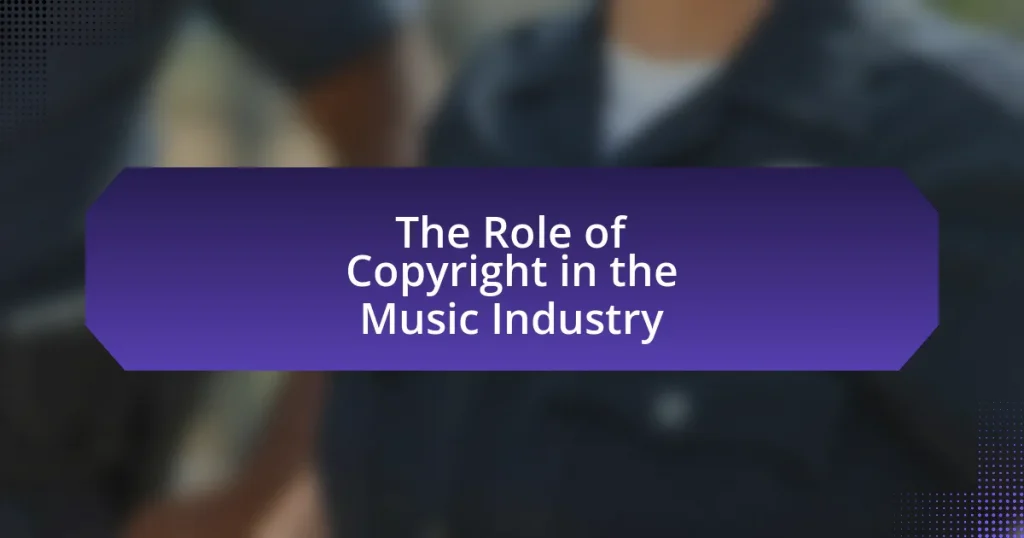Copyright is a fundamental aspect of video game development, providing legal protection for the intellectual property of creators, including game design, artwork, music, and code. This article outlines how copyright safeguards the rights of video game developers, enabling them to control the use and distribution of their creations while preventing unauthorized reproduction. It discusses the types of works protected under copyright law, the differences between copyright and other forms of intellectual property, and the importance of copyright in fostering innovation within the gaming industry. Additionally, the article addresses common copyright disputes, the implications for collaboration in game projects, and best practices for developers to navigate copyright issues effectively.

What is the Role of Copyright in Video Game Development?
Copyright plays a crucial role in video game development by protecting the intellectual property of creators, including game design, artwork, music, and code. This legal protection allows developers to control the use and distribution of their creations, preventing unauthorized reproduction and ensuring that they can monetize their work. For instance, the U.S. Copyright Act grants creators exclusive rights to their original works, which can include video games, thus enabling them to pursue legal action against infringement. Additionally, copyright encourages innovation by providing a framework that rewards creativity, as developers can secure their investments and efforts in creating unique gaming experiences.
How does copyright protect video game creators?
Copyright protects video game creators by granting them exclusive rights to their original works, including the game’s code, graphics, music, and storyline. This legal protection prevents unauthorized reproduction, distribution, and adaptation of their creations, allowing creators to control how their work is used and monetized. For instance, under the U.S. Copyright Act, video game developers can sue for infringement if someone copies or distributes their game without permission, thereby safeguarding their intellectual property and potential revenue.
What types of works are protected under copyright law in video games?
Copyright law protects various types of works in video games, including software code, graphics, music, sound effects, character designs, storylines, and user interfaces. Each of these elements is considered an original work of authorship, which qualifies for copyright protection under the U.S. Copyright Act. For instance, the software code is protected as a literary work, while the visual art and character designs are protected as artistic works. Additionally, the music and sound effects are protected as musical compositions and sound recordings, respectively. This comprehensive protection ensures that creators retain exclusive rights to their original expressions within the video game medium.
How does copyright differ from other forms of intellectual property in gaming?
Copyright protects the expression of ideas in gaming, such as the game’s code, graphics, and music, while other forms of intellectual property, like patents and trademarks, protect different aspects. Specifically, patents cover inventions and processes used in game development, such as unique gameplay mechanics, whereas trademarks protect brand identifiers, including game titles and logos. Copyright is automatic upon creation and does not require registration, unlike patents, which require a formal application process, and trademarks, which must be actively maintained. This distinction is crucial in the gaming industry, where the creative elements are often the primary focus of copyright, while functional and branding aspects are safeguarded by patents and trademarks, respectively.
Why is copyright important for the video game industry?
Copyright is crucial for the video game industry because it protects the intellectual property of developers, ensuring that their creative works cannot be used without permission. This legal protection incentivizes innovation and investment, as developers can secure their financial interests and recover costs associated with game development. For instance, the Entertainment Software Association reported that the U.S. video game industry generated over $90 billion in revenue in 2020, highlighting the economic significance of protecting original content. Without copyright, developers would face increased risks of piracy and unauthorized use, which could undermine the industry’s growth and sustainability.
What are the potential consequences of copyright infringement in video games?
Copyright infringement in video games can lead to significant legal and financial consequences for the infringing party. Legal actions may include lawsuits filed by copyright holders, resulting in monetary damages that can reach millions of dollars, as seen in cases like the lawsuit against the creators of “Fortnite” for using assets from “PUBG,” which resulted in a settlement. Additionally, copyright infringement can lead to the issuance of cease-and-desist orders, forcing the infringing party to halt distribution and sales of the infringing game. This not only impacts revenue but can also damage the reputation of the infringing party within the industry. Furthermore, repeated infringement can result in more severe penalties, including statutory damages and potential criminal charges, depending on the jurisdiction and severity of the infringement.
How does copyright contribute to innovation in game development?
Copyright fosters innovation in game development by providing legal protection for original ideas, characters, and mechanics, which encourages developers to invest time and resources into creating unique content. This protection allows creators to monetize their work without the fear of unauthorized use, leading to increased investment in research and development. For instance, the success of franchises like Super Mario and The Legend of Zelda demonstrates how copyright enables developers to build upon their intellectual property, resulting in innovative gameplay mechanics and storytelling techniques. By safeguarding creative works, copyright incentivizes the continuous evolution of the gaming industry, driving technological advancements and new gaming experiences.
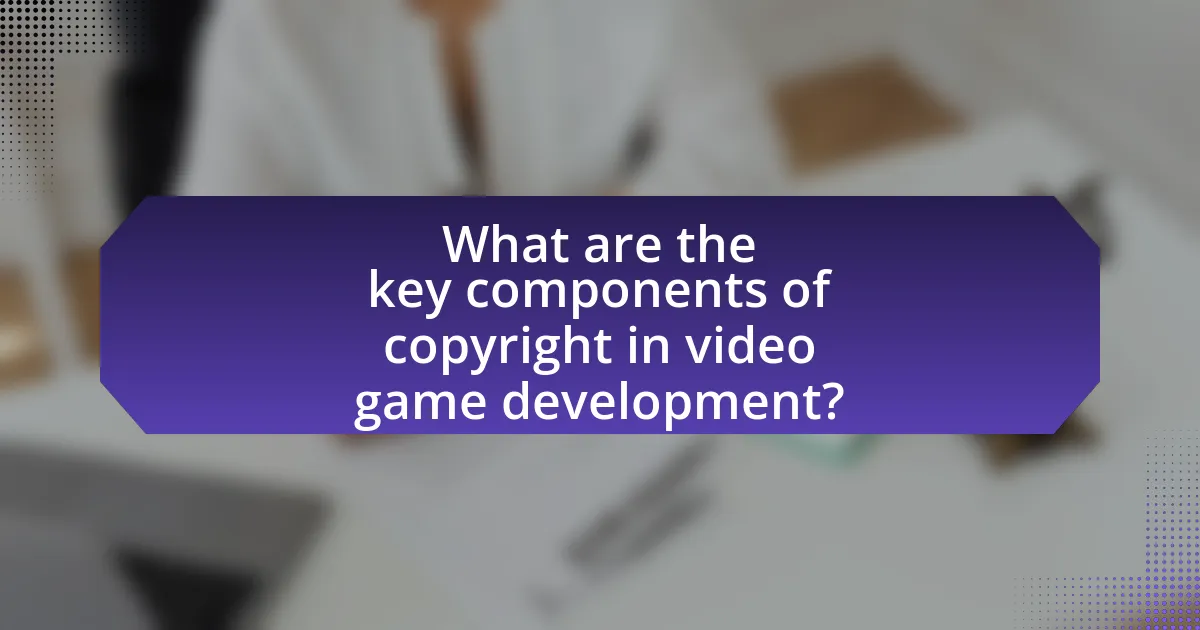
What are the key components of copyright in video game development?
The key components of copyright in video game development include the protection of original works, the rights of creators, and the duration of copyright. Original works such as game code, graphics, music, and storylines are automatically protected by copyright upon creation, ensuring that developers have exclusive rights to reproduce, distribute, and display their creations. The rights of creators encompass the ability to license or sell these rights, which can be crucial for monetization and collaboration. Copyright duration typically lasts for the life of the creator plus 70 years, providing long-term protection for the intellectual property involved in video games. These components are essential for safeguarding the interests of developers and fostering innovation within the industry.
What rights do copyright holders have in video games?
Copyright holders in video games possess exclusive rights to reproduce, distribute, perform, display, and create derivative works based on the game. These rights enable copyright holders to control how their games are used and monetized, ensuring that they can profit from their creative efforts. For instance, under the U.S. Copyright Act, video game developers can prevent unauthorized copying or distribution of their games, which protects their intellectual property and revenue streams. Additionally, copyright holders can license their games to others, allowing for controlled use while retaining ownership.
How can copyright holders enforce their rights against infringement?
Copyright holders can enforce their rights against infringement through legal actions such as sending cease-and-desist letters, filing lawsuits, and seeking statutory damages. These actions are grounded in copyright law, which grants creators exclusive rights to their works, allowing them to take action against unauthorized use. For instance, the U.S. Copyright Act provides for statutory damages of up to $150,000 per work infringed if the infringement is found to be willful, reinforcing the legal framework that supports enforcement. Additionally, copyright holders can utilize digital rights management (DRM) technologies to prevent unauthorized copying and distribution of their works, further protecting their intellectual property in the video game industry.
What limitations exist on the rights of copyright holders in gaming?
Copyright holders in gaming face limitations primarily due to the doctrine of fair use, which allows for certain uses of copyrighted material without permission. Fair use can include commentary, criticism, or educational purposes, which are often applicable in gaming contexts such as reviews or tutorials. Additionally, the first sale doctrine permits the resale of legally purchased games, restricting copyright holders’ control over distribution. Furthermore, the Digital Millennium Copyright Act (DMCA) includes provisions that protect users’ rights to modify or create derivative works under specific conditions, thereby limiting the scope of copyright enforcement. These limitations are essential for fostering creativity and innovation within the gaming industry while balancing the rights of creators and consumers.
How does copyright impact collaboration in game development?
Copyright significantly impacts collaboration in game development by establishing legal ownership and usage rights for creative works. This legal framework ensures that all contributors, such as artists, programmers, and writers, understand their rights and responsibilities regarding the intellectual property they create. For instance, if a game developer uses copyrighted music without permission, they risk legal action, which can disrupt collaboration and project timelines. Furthermore, clear copyright agreements can facilitate smoother teamwork by delineating how shared assets can be used, thus preventing disputes and fostering a more productive collaborative environment.
What are the implications of copyright for team-based game projects?
Copyright implications for team-based game projects include ownership rights, distribution of royalties, and protection against infringement. In a collaborative environment, determining who holds the copyright for various elements—such as code, art, and music—can lead to disputes if not clearly defined in contracts. For instance, if a team member creates a character design, the copyright may belong to that individual unless the team agreement states otherwise. Additionally, revenue sharing from the game’s sales must be outlined to avoid conflicts over profits. Copyright also provides legal protection, allowing teams to defend their work against unauthorized use, which is crucial in a competitive industry where ideas can be easily replicated.
How can developers navigate copyright issues when working with third-party assets?
Developers can navigate copyright issues when working with third-party assets by conducting thorough due diligence on the licensing agreements associated with those assets. This involves reviewing the terms of use, ensuring compliance with any restrictions, and obtaining necessary permissions or licenses from the copyright holders. For instance, using assets from platforms like Unity Asset Store or Adobe Stock requires adherence to their specific licensing terms, which often dictate how assets can be used in commercial projects. Additionally, developers should consider utilizing assets that are explicitly labeled as royalty-free or under Creative Commons licenses, as these often come with fewer restrictions. By understanding and respecting copyright laws, developers can mitigate the risk of legal disputes and ensure their projects remain compliant.
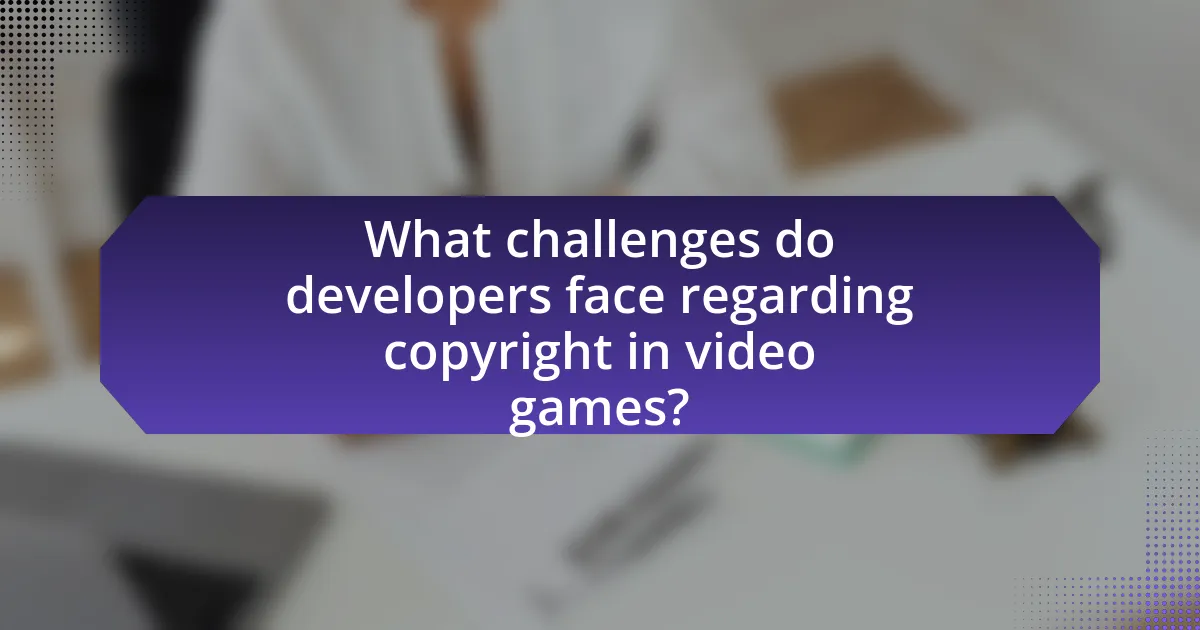
What challenges do developers face regarding copyright in video games?
Developers face significant challenges regarding copyright in video games, primarily due to the complexity of intellectual property laws and the potential for infringement. The diverse elements in video games, such as code, graphics, music, and storylines, can lead to disputes over ownership and rights. For instance, the use of third-party assets without proper licensing can result in legal action, as seen in cases like the lawsuit against the game “Fortnite” for allegedly using a dance move without permission. Additionally, the rapid pace of game development often leads to unintentional copyright violations, as developers may not fully understand the legal implications of their work. These challenges necessitate a thorough understanding of copyright law and diligent management of intellectual property to avoid costly litigation and ensure compliance.
What are common copyright disputes in the gaming industry?
Common copyright disputes in the gaming industry include issues related to unauthorized use of copyrighted materials, infringement of character designs, and disputes over music licensing. Unauthorized use occurs when developers incorporate elements from existing games without permission, leading to legal action from original creators. Infringement of character designs often arises when new games feature characters that closely resemble those from established franchises, prompting lawsuits to protect intellectual property. Music licensing disputes frequently occur when games use copyrighted music without securing the necessary rights, resulting in claims from artists or record labels. These disputes highlight the importance of copyright in protecting the creative works within the gaming industry.
How can developers avoid copyright infringement in their games?
Developers can avoid copyright infringement in their games by ensuring that all content, including graphics, music, and code, is either original, licensed, or falls under fair use. This involves creating unique assets, obtaining permissions for third-party materials, and understanding the limitations of fair use, which allows limited use of copyrighted material without permission under specific circumstances. For instance, the U.S. Copyright Office outlines that fair use can apply to commentary, criticism, or educational purposes, but developers must carefully evaluate their use case to avoid legal issues. Additionally, conducting thorough research on copyright laws and consulting legal experts can further safeguard against infringement.
What role does fair use play in video game development?
Fair use plays a critical role in video game development by allowing developers to incorporate copyrighted material without seeking permission, under certain conditions. This legal doctrine enables the use of elements such as music, art, and code from existing works for purposes like commentary, criticism, or parody, which can enhance gameplay and storytelling. For instance, the case of “Capcom v. Mike’s Arcade” illustrates how fair use can protect developers who create derivative works that comment on or transform the original material. By providing a framework for limited use, fair use fosters creativity and innovation in the gaming industry while balancing the rights of original creators.
How can developers protect their own creations?
Developers can protect their own creations by obtaining copyright for their original works. Copyright law grants creators exclusive rights to reproduce, distribute, and display their creations, which is crucial in the video game industry where intellectual property is a significant asset. For instance, the U.S. Copyright Office allows developers to register their games, providing legal evidence of ownership and the ability to enforce rights against infringement. This legal framework helps safeguard against unauthorized use and reproduction, ensuring that developers can monetize their creations effectively.
What steps should developers take to register their copyrights?
Developers should take the following steps to register their copyrights: first, they must create an original work that is fixed in a tangible medium, such as code, graphics, or music. Next, they should complete the appropriate copyright application form, which can be found on the U.S. Copyright Office website. After filling out the form, developers need to submit it along with a non-refundable filing fee and a copy of the work being registered. Finally, they should wait for the U.S. Copyright Office to process the application, which can take several months, after which they will receive a certificate of registration. This process is essential as it provides legal protection and establishes a public record of the copyright.
How can developers effectively document their creative process for copyright purposes?
Developers can effectively document their creative process for copyright purposes by maintaining detailed records of their work, including sketches, drafts, and version histories. This documentation should include timestamps, descriptions of the creative decisions made, and any collaborative contributions, as these elements establish a clear timeline and ownership of the creative output. For instance, using version control systems like Git allows developers to track changes and contributions over time, providing a verifiable history of the development process. Additionally, keeping dated notes and logs can serve as evidence of the evolution of ideas, which is crucial in copyright disputes. This method aligns with copyright law, which protects original works of authorship fixed in a tangible medium, thus reinforcing the importance of thorough documentation in safeguarding intellectual property rights.
What best practices should developers follow regarding copyright?
Developers should ensure they understand and comply with copyright laws to protect their intellectual property and avoid infringement. This includes obtaining licenses for any third-party content used, such as music, art, or code, and creating original content to minimize legal risks. Additionally, developers should document their work processes and maintain clear records of ownership for all created assets. According to the U.S. Copyright Office, copyright protection is automatic upon the creation of original works, but registering these works can provide additional legal benefits, such as the ability to sue for statutory damages.
How can developers stay informed about copyright law changes affecting video games?
Developers can stay informed about copyright law changes affecting video games by regularly following legal updates from reputable sources such as the U.S. Copyright Office, industry associations like the Entertainment Software Association, and legal blogs specializing in intellectual property. These sources provide timely information on legislative changes, case law, and best practices relevant to copyright in the gaming industry. Additionally, attending industry conferences and workshops can offer insights from legal experts and networking opportunities with peers who share knowledge on copyright issues.
What resources are available for understanding copyright in the gaming industry?
Resources available for understanding copyright in the gaming industry include legal textbooks, online courses, and industry-specific websites. Legal textbooks such as “Copyright Law in a Nutshell” by Arthur R. Miller provide foundational knowledge on copyright principles applicable to gaming. Online platforms like Coursera and Udemy offer courses focused on intellectual property rights, including copyright in digital media. Additionally, websites like the U.S. Copyright Office and the International Game Developers Association (IGDA) provide guidelines, articles, and resources tailored to game developers, ensuring they understand their rights and obligations under copyright law.

